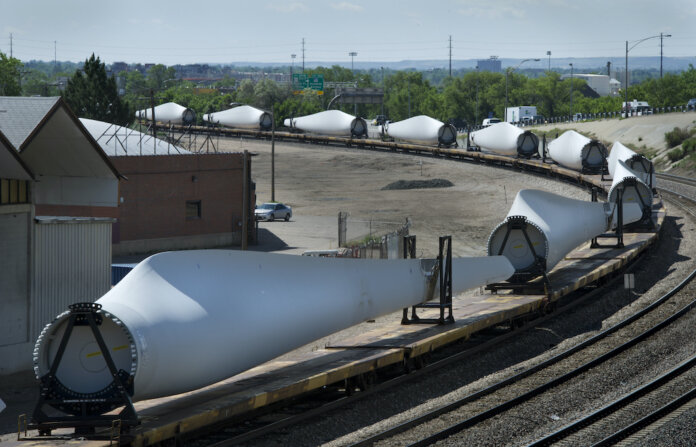Researchers at the U.S. Department of Energy’s (DOE) National Renewable Energy Laboratory (NREL) have determined how to transport massive wind turbine blades to parts of the country at a lower cost than segmented blades, but the solution will require some flexibility on the part of the industry.
Manufacturing blades that can bend with “controlled flexing” will allow railroads to ship longer blades around the U.S. Because of bends, twists and turns in railroad lines, the upper limit for transporting single-piece land-based blades by rail is currently 75 meters. The conceptual design envisioned by researchers would stretch that limit to 100 meters or beyond for land-based turbines. Blades of this length are already being proposed for offshore wind turbines and can be transported via barge, but they have not been installed inland due to the transportation constraints.
For land-based turbines, the longer blades could be shipped attached across the length of four railcars.
Longer blades and taller wind turbines allow for the greater production of energy, even in areas where wind speeds are low. Seeking an economical solution to installing wind turbines has kept wind farms from regions where the resource could potentially be harvested, including the southeast areas of the U.S. The flexible blade technology may enable more deployment in these areas in the future due to the lower cost. Lowering the cost of transportation and enabling rotors with a higher capacity factor could make these deployments more economically feasible.
“This research can aid in massive deployment of wind energy in different regions of the country – even parts of the country that typically haven’t seen as much deployment,” states Nick Johnson, a mechanical engineer at NREL’s National Wind Technology Center and co-lead of the U.S. Department of Energy’s Big Adaptive Rotor Project (BAR). He is also co-author of a new paper, “Land-based wind turbine with flexible rail-transportable blades,” which appears in the journal Wind Energy Science.
BAR emerged from a 2018 workshop on supersized land-based wind turbine blades. In addition to NREL, other BAR partners are Sandia National Laboratories, Oak Ridge National Laboratory and Lawrence Berkeley National Laboratory. Engineers at the international organization DNV GL, which has a working relationship with NREL, in 2019 proposed on a conceptual level the controlled flexing of the blades during rail transport. The new paper provides an in-depth investigation into the idea.
Co-authors on the paper are NREL’s Pietro Bortolotti and Nikhar Abbas, and Sandia’s Evan Anderson, Ernesto Camarena and Joshua Paquette.
The paper considers a 5 MW wind turbine installed on a 140-meter-tall tower.
The scientists examined the potential for five designs that represent the next generation of land-based turbines. They modeled the designs using NREL’s Wind Plant Integrated System Design and Engineering Model (WISDEM) software to determine the best option. One idea, that of cutting a blade in two for transport, was among those considered as a baseline that considers existing technology. The analysis showed that while this is a feasible solution, it does not have the same cost benefits as shipping the single-piece, rail-transportable blade.





The railroad is already damaging quite a few 62 meter blades I can’t imagine them hauling anyting longer. I was in Larned Kansas and every 62 m blade that was delivered with damaged.